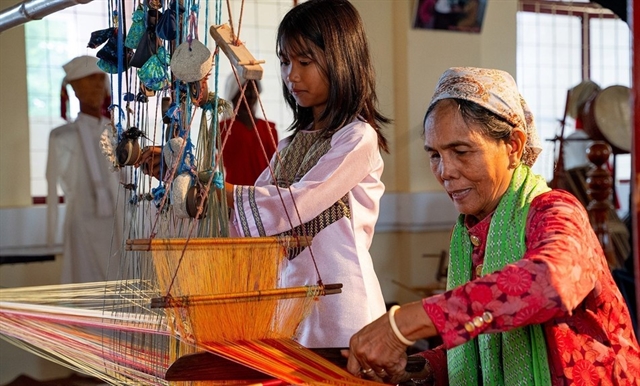 Features
Features
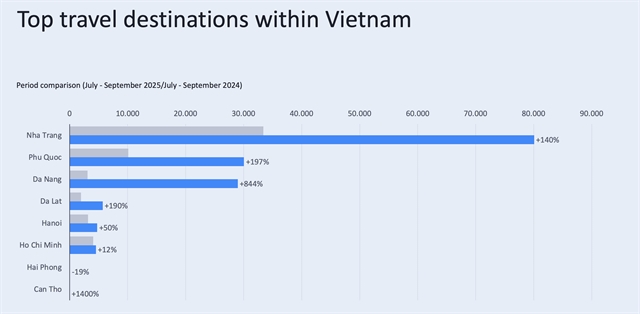
Colourful bamboo dragonflies perched on thin, pointed bamboo sticks are not just cute souvenir toys, they reflect the agricultural traditions and craftmanship of Vietnamese farmers.
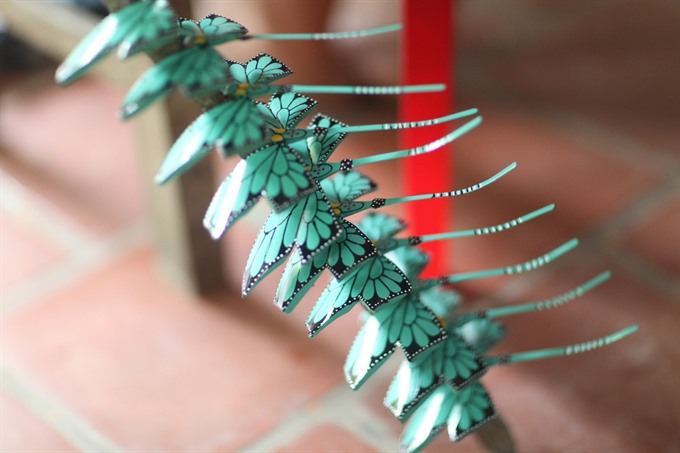 |
| Almost done: Bamboo dragonflies put out to dry after being painted. VNS Photo Trần Hoàng Nam |
Colourful bamboo dragonflies perched on thin, pointed bamboo sticks are not just cute souvenir toys, they reflect the agricultural traditions and craftmanship of Vietnamese farmers. It is the simplest of toys to play with, but great care goes into making them, from choosing the most pliable material to crafting each stage with enormous patience, Lê Hương discovers on a visit to a quiet village in Ha Noi.
Here and there in souvenir shops on downtown streets are colourful bamboo dragonflies perching on bamboo pillars.
The toys can be given as presents to both children and adults, being a special gift displaying agricultural culture and skillful farmers.
The toys may remind elders of their childhoods, when losing themselves while catching dragonflies in the countryside.
A "kingdom" of bamboo dragonflies can be found just 35km west of the capital centre – in a quiet village near ancient Tây Phương Pagoda, in Thạch Xá Commune, Thạch Thất District.
Just at the entrance to the brick steps leading to the pagoda on top of a hill, one can find many vendors offering bamboo toys, such as dragonflies, birds and tortoises.
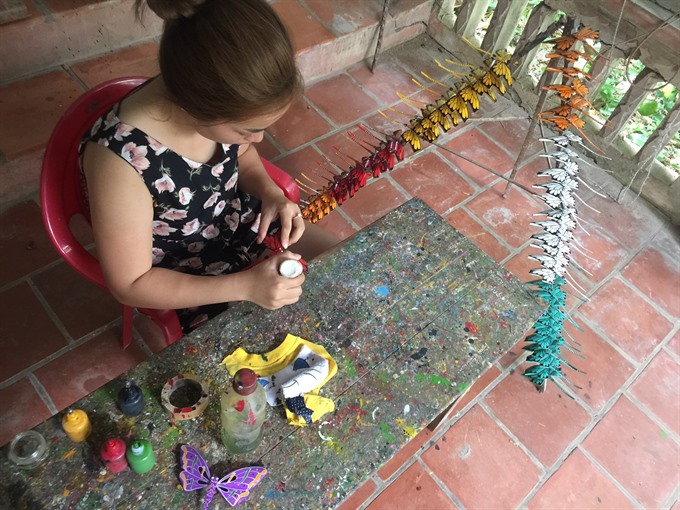 |
| Busy bee: On average, a family in the village produces 7,000 toys every month for domestic and foreign markets. VNS Photo Trần Hoàng Nam |
Also inside is the “motherland” of the toys just at the foot of the hill.
The house of Nguyễn Văn Tái, who has made toys for the past 16 years, is located in a nearby lane, where visitors can see many bamboo branches drying in the sun.
Tái’s products are famed for their beauty, durability, variety in genres and reasonable prices.
“I started to specialise in making bamboo toys in 2000,” Tái told Việt Nam News, “Before that, I had other jobs, in building and farming.”
“I did not learn from anyone how to make toys from bamboo. I just imitated some models I found at that time. Then, the more I work, the more experience I had to make the products more beautiful and interesting to play with.”
There are many stages in the toy making process, including choosing proper bamboo, carving, and decorating the toys.
“Every stage requires great patience, hard work and care,” Tái said. “It looks so simple, but the bamboo toy would lose it balance and would not have a good shape if the craftsman performed a single stage in a hurry.”
According to Tái the most difficult stage is carving the toy’s form, so that it is beautiful and balanced, because the most important feature of the toy is for the dragonflies or birds to perch on any small place, such as the top of a finger or a chopstick, as they do in nature.
Tái often sells all of these products, offering them wholesale to partners throughout the country and overseas.
“Foreign customers have stricter demands,” he said. “The bamboo we use should not be treated in chemicals, so that the products are not harmful.”
Tái stressed that the bamboo selected cannot be too young or too old.
It must reach a mature level so that it is strong, soft, easy-to-carve and free of termites or other insects, and have a shiny surface. He always chooses bamboo from forests in the Northern provinces of Hà Giang, Hòa Bình and Vĩnh Phúc.
The bamboo’s outer skin is then removed, and dried for 4-5 weeks before being cut into small pieces for carving parts of dragonflies, butterflies or tortoises.
His most popular toys are dragonflies. Though many households in the area make the same products, Tái’s dragonflies are considered the most beautiful, as he takes great care in the details.
Tái explained that he could not create any part of the toy with a machine, because bamboo is easily broken.
The selling of toys has created a stable income for Tái’s family and hundreds of people in the area.
On average, a family produces 7,000 toys every month for domestic and foreign markets.
“This business can employ many family members, from children to elders,” Tái said.
Nguyễn Như Quỳnh, a worker from Tái’s workshop, said she hoped to earn a long-term and stable living through her job.
“More importantly, it helps maintain folk toys in these modern times,” Tái said.
“As a young worker, I hope to find new ways to open foreign markets, rather than having to go through middle people," she said.
Tái has co-ordinated with the children’s protection organization Cenforchil, under the Việt Nam Union of Science and Technology Associations and MyHanoi organisation, in projects for researching and preserving Vietnamese traditional toys. — VNS
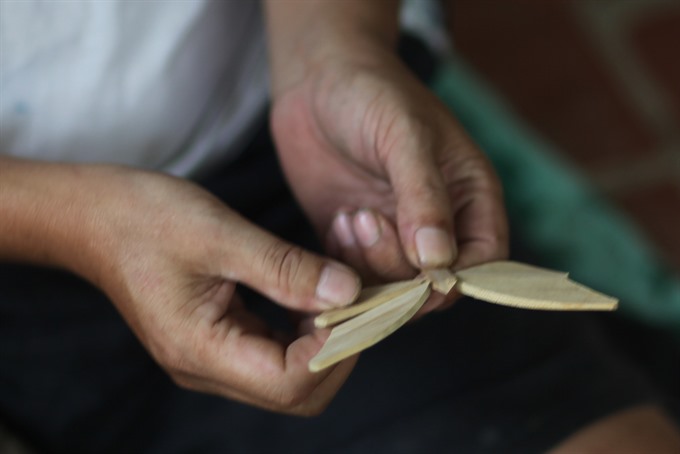 |
| Fragile bamboo: Carving the delicate forms of toys is the most difficult stage. VNS Photo Trần Hoàng Nam |
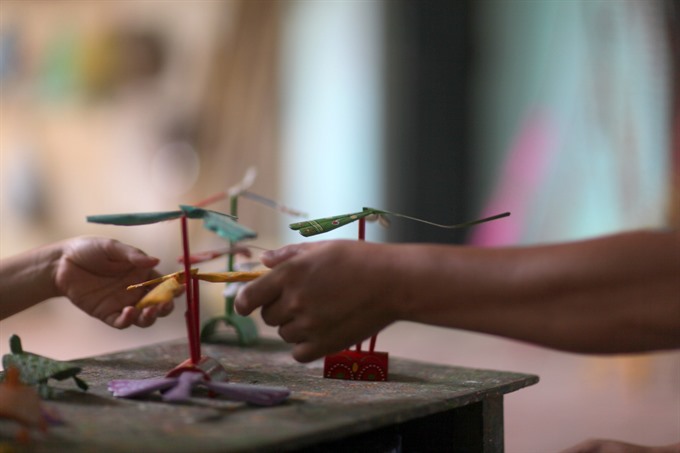 |
| Balanced: The toys should be able to perch on a small point. VNS Photo Trần Hoàng Nam |
 |
| Stacked: Bamboo dragonflies before painting. VNS Photo Trần Hoàng Nam |